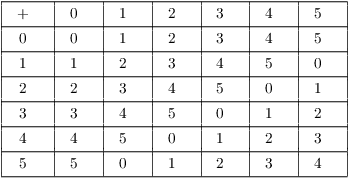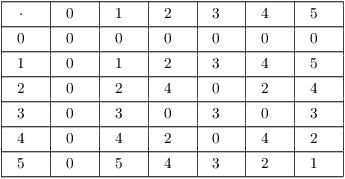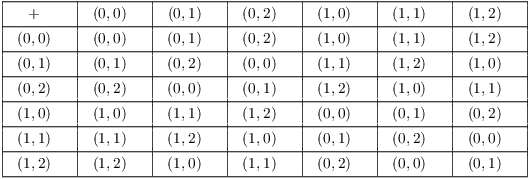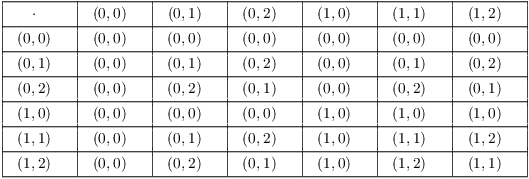Definition. Let R and S be rings. A ring homomorphism (or a ring
map for short) is a function ![]() such that:
such that:
(a) For all ![]() ,
, ![]() .
.
(b) For all ![]() ,
, ![]() .
.
Usually, we require that if R and S are rings with 1, then
(c) ![]() .
.
This is automatic in some cases; if there is any question, you should read carefully to find out what convention is being used.
The first two properties stipulate that f should "preserve" the ring structure --- addition and multiplication.
Example. ( A ring map on the
integers mod 2) Show that the following function ![]() is a ring map:
is a ring map:
![]()
First,
![]()
![]() because 2 times anything is 0 in
because 2 times anything is 0 in ![]() .
.
Next,
![]()
The second equality follows from the fact that ![]() is commutative.
is commutative.
Note also that ![]() .
.
Thus, f is a ring homomorphism.![]()
Example. ( An additive
function which is not a ring map) Show that the following
function ![]() is not a ring map:
is not a ring map:
![]()
Note that
![]()
Therefore, g is additive --- that is, g is a homomorphism of abelian groups.
But
![]()
Thus, ![]() , so g is not a ring map.
, so g is not a ring map.![]()
Lemma. Let R and S be rings and let ![]() be a ring map.
be a ring map.
(a) ![]() .
.
(b) ![]() for all
for all ![]() .
.
Proof. (a)
![]()
(b) By (a),
![]()
But this says that ![]() is the additive inverse of
is the additive inverse of ![]() , i.e.
, i.e. ![]() .
.![]()
These properties are useful, and they also lend support to the idea that ring maps "preserve" the ring structure. Now I know that a ring map not only preserves addition and multiplication, but 0 and additive inverses as well.
Warning! A ring map f must satisfy ![]() and
and ![]() , but these are not part
of the definition of a ring map. To check that something is
a ring map, you check that it preserves sums and products.
, but these are not part
of the definition of a ring map. To check that something is
a ring map, you check that it preserves sums and products.
On the other hand, if a function does not satisfy ![]() and
and ![]() , then it isn't a ring
map.
, then it isn't a ring
map.
Example. ( Showing that a
function is not a ring map) (a) Show that the following function
![]() is not a ring map:
is not a ring map:
![]()
(b) Show that the following ![]() is not a
ring map:
is not a
ring map:
![]()
(a) ![]() .
.![]()
(b) ![]() and
and ![]() for all
for all ![]() . Nevertheless, g is not a ring map:
. Nevertheless, g is not a ring map:
![]()
Thus, ![]() , so g does not preserve
products.
, so g does not preserve
products.![]()
Lemma. Let R, S, and T be rings, and let ![]() and
and ![]() be ring maps. Then the composite
be ring maps. Then the composite
![]() is a ring map.
is a ring map.
Proof. Let ![]() . Then
. Then
![]()
![]()
If, in addition, R, S, and T are rings with identity, then
![]()
Therefore, ![]() is a ring map.
is a ring map.![]()
There is an important relationship between ring maps and ideals. I'll consider half of the relationship now.
Definition. The kernel
of a ring map ![]() is
is
![]()
The image of a ring map ![]() is
is
![]()
The kernel of a ring map is like the null space of a linear transformation of vector spaces. The image of a ring map is like the column space of a linear transformation.
Proposition. The kernel of a ring map is a two-sided ideal.
In fact, I'll show later that every two-sided ideal arises as the kernel of a ring map.
Proof. Let ![]() be a
ring map. Let
be a
ring map. Let ![]() , so
, so ![]() and
and ![]() . Then
. Then
![]()
Hence, ![]() .
.
Since ![]() ,
, ![]() .
.
Next, if ![]() , then
, then ![]() . Hence,
. Hence, ![]() , so
, so ![]() (why?), so
(why?), so ![]() .
.
Finally, let ![]() and let
and let ![]() .
.
![]()
![]()
It follows that ![]() . Hence,
. Hence, ![]() is a two-sided ideal.
is a two-sided ideal.![]()
I'll omit the proof of the following result. Note that it says the image of a ring map is a subring, not an ideal.
Proposition. Let ![]() be a
ring map. Then
be a
ring map. Then ![]() is a subring of S.
is a subring of S.![]()
Definition. Let R and S be rings. A ring isomorphism from R to S is a bijective ring
homomorphism ![]() .
.
If there is a ring isomorphism ![]() , R and S are isomorphic. In this case, we write
, R and S are isomorphic. In this case, we write ![]() .
.
Heuristically, two rings are isomorphic if they are "the same" as rings.
An obvious example: If R is a ring, the identity map ![]() is an isomorphism of R with itself.
is an isomorphism of R with itself.
Since a ring isomorphism is a bijection, isomorphic rings must have
the same cardinality. So, for example, ![]() , because the two rings have different numbers of
elements.
, because the two rings have different numbers of
elements.
However, ![]() and
and ![]() have the
"same number" of elements --- the same
cardinality --- but they are not isomorphic as rings. (Quick
reason:
have the
"same number" of elements --- the same
cardinality --- but they are not isomorphic as rings. (Quick
reason: ![]() is a field, while
is a field, while ![]() is only an integral domain.)
is only an integral domain.)
I've been using this construction informally in some examples. Here's the precise definition.
Definition. Let R and S be rings. The product ring ![]() of R and S is the set
consisting of all ordered pairs
of R and S is the set
consisting of all ordered pairs ![]() , where
, where ![]() and
and ![]() . Addition and multiplication are
defined component-wise: For
. Addition and multiplication are
defined component-wise: For ![]() and
and ![]() ,
,
![]()
![]()
I won't go through the verification of all the axioms; basically,
everything works because everything works in each component
separately. For example, here's the verification of the associative
law for addition. Let ![]() ,
, ![]() . Then
. Then
![]()
![]()
The third equality used associativity of addition in R and in S.
The additive identity is ![]() ; the additive inverse
; the additive inverse ![]() of
of ![]() is
is ![]() . And so on. Try out one or
two of the other axioms for yourself just to get a feel for how
things work.
. And so on. Try out one or
two of the other axioms for yourself just to get a feel for how
things work.
Example. ( A ring isomorphic
to a product of rings) Show that ![]() .
.
![]() with addition and
multiplication mod 6. On the other hand,
with addition and
multiplication mod 6. On the other hand,
![]()
One ring consists of single elements, while the other consists of pairs. Nevertheless, these rings are isomorphic --- they are the same as rings.
Here are the addition and multiplication tables for ![]() :
:


Here are the addition and multiplication tables for ![]() .
.


The two rings each have 6 elements, so it's easy to define a bijection from one to the other --- for example,
![]()
However, this is not a ring isomorphism:
![]()
Thus, ![]() .
.
It turns out, however, that the following map gives a ring
isomorphism ![]() :
:
![]()
It's obvious that the map is a bijection. To prove that this
is a ring isomorphism, you'd have to check 36 cases for ![]() and another 36 cases for
and another 36 cases for ![]() .
.![]()
Example. ( Showing that a
product of rings which is not isomorphic to another ring) Show
that the rings ![]() and
and ![]() are not isomorphic.
are not isomorphic.
![]() and
and ![]() aren't
isomorphic as groups under addition. Since a ring isomorphism must
give an isomorphism of the two rings considered as groups under
addition,
aren't
isomorphic as groups under addition. Since a ring isomorphism must
give an isomorphism of the two rings considered as groups under
addition, ![]() and
and ![]() can't be isomorphic as rings.
can't be isomorphic as rings.
To see this directly, suppose ![]() is an isomorphism. Then
is an isomorphism. Then ![]() ,
because everything in
,
because everything in ![]() gives 0 when
added to itself. But since f is a ring map,
gives 0 when
added to itself. But since f is a ring map,
![]()
Therefore, ![]() .
.
But I know that ![]() , because any ring map takes the
additive identity to the additive identity. Now I have two elements 2
and 0 which both map to
, because any ring map takes the
additive identity to the additive identity. Now I have two elements 2
and 0 which both map to ![]() , and this contradicts the fact
that f is injective.
, and this contradicts the fact
that f is injective.
Therefore, there is no such f, and the rings aren't isomorphic.![]()
Copyright 2018 by Bruce Ikenaga